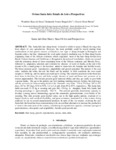Please use this identifier to cite or link to this item:
http://www.alice.cnptia.embrapa.br/alice/handle/doc/529936| Title: | Ovinos Santa Inês: estado de arte e perspectivas. |
| Authors: | SOUSA, W. H. de  LOBO, R. N. B.   MORAIS, O. R.   |
| Affiliation: | WANDRICK HAUS DE SOUSA, EMEPA-PB RAIMUNDO NONATO BRAGA LOBO, CNPC OCTAVIO ROSSI MORAIS. |
| Date Issued: | 2003 |
| Citation: | In: SIMPÓSIO INTERNACIONAL SOBRE CAPRINOS E OVINOS DE CORTE, 2.; SIMPÓSIO INTERNACIONAL SOBRE AGRONEGÓCIO DA CAPRINOCULTURA LEITEIRA, 1., 2003, João Pessoa. Anais... João Pessoa: EMEPA-PB, 2003. p. 501-522. |
| Description: | [Santa Inês hair sheep: state of art and perspectives]. Abstract: The Santa Inês hair sheep breed is found in whole to areas of Brazil. Its origin has been object of vary speculations. However, the most probable could be traced starting from combinations of four genetic sources: a) Criuola is wool type of sheep, brought by Portuguese and Spanish settlers, but that eliminated the wool under tropical conditions was; b) Hair sheep breeds originating from of the African continent, which originated most of the hair sheep breeds from Brazil, Central America and Caribbean; c) Bergamácia sheep breed from Italian, which was crossed with the remaining sheep of those originating from of the African continent, and Morada Nova, followed by adaptation, selection and evolution for absence of wool; d) finally, in the end of the decade of 80, a small group of the breeders added to Santa Inês the Somalis and Suffolk breeds. The breed presents good reproductive, adaptability and growth potential. The pattern of the coat calor includes the white, the red, the black and the mailed. In field conditions the ewes reach weights of 40-60 kg and the males can reach up to 120 kg. The selection practiced in the breed has been done in direction for size and body weight, absence of wool and horns and, presence of an intense pigmentation. The females present good maternal ability and they get easily to give birth vigorous lambs. The age to the puberty and first lambing, lambing interval, fertility, the prolificacy and the survival rate from weaning found in the literature, vary from: 274 to 376 days, 442 to 551 days, 227 to 307 days, 83,6 to 93%, 1,1 to 1,4 and, from 69 to 87%, respectively. The Santa Inês lamb can reach 23-32 kg at weaning and gain 166 -336 kg. At slaughter, Santa Inês Lamb, had dressing percentage of approximately 48,0 %. The animals generally demonstrate capacity to develop a strong answer immunology against the nematodes gastrontestinais, even before of the weaning. That skin presents great market value, due to the high quality pattern, resultant of its largest elasticity and excellent flexibility, and great resistance, associated to a fine texture, being rendered for use in several manufactured products. In spite of the few studies involving the face Santa Inês the breed has been demonstrating to be an excellent alternative to increase the production of meat in the main areas of the country, considering its reproductive capacity, resistance sponges it gastrontestinais, skin quality and adaptability , besides good growth rate. |
| Thesagro: | Ovino Carne Leite Carcaça Crescimento Reprodução animal Pele |
| NAL Thesaurus: | Sheep meat Mutton Sheep Milk Animal growth Reproduction Ovine carcasses Skin (animal) |
| Keywords: | Raça Santa Inês |
| Type of Material: | Artigo em anais e proceedings |
| Access: | openAccess |
| Appears in Collections: | Artigo em anais de congresso (CNPC)  |
Files in This Item:
| File | Description | Size | Format | |
|---|---|---|---|---|
| AACOvinosSantaInes.pdf | 141.59 kB | Adobe PDF |  View/Open |









